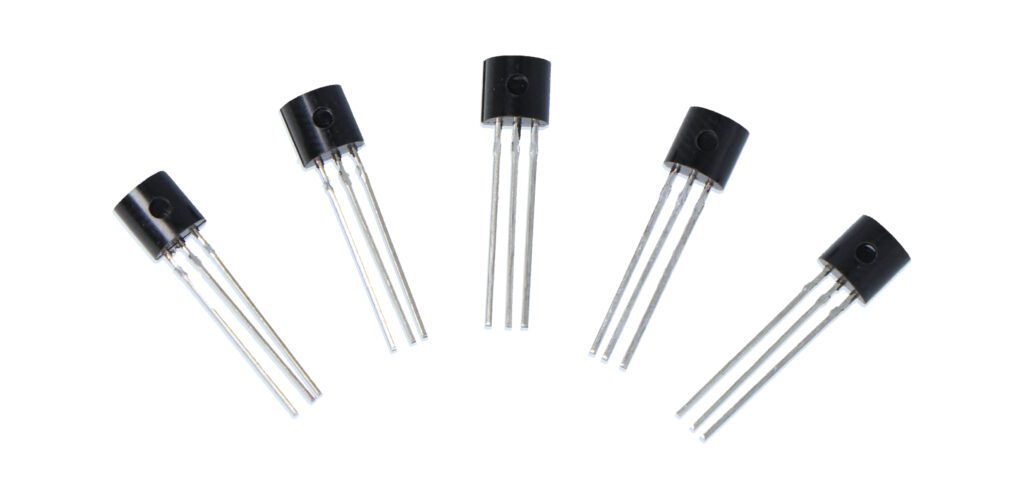Table of Contents:
The transistor is one of the most common semiconductor devices in electronics. With its help, we can build a variety of electronic circuits and devices for both amateur and professional use. Among the various types of transistors, we distinguish, among others junction bipolar transistors, which are characterized by NPN or PNP conduction type. The latter include, among others transistor with the alphanumeric symbol BC557. In this article, we will learn about its parameters and principle of operation, and do a summary of the strengths and weaknesses of this component.
BC557 transistor - introduction
A transistor is a component with three leads that is used to switch or amplify electrical and electronic signals. Transistors in modern electronics, play a key role. The BC557 transistor is a very well-known BJT (bipolar) transistor of the PNP type, available, among others. In a TO-92 housing designed for through-hole mounting. Such a transistor is typically used as a switch or current amplifier in electronic circuits and systems.
BC557 - technical parameters
- Housing: TO92
- Conductivity type: PNP
- Maximum collector current (Ic): -100mA
- Maximum operating temperature: -65*C – +150*C
- Maximum collector-emitter voltage (VCE max): -45V
- Minimum/Maximum constant current amplification (hFE): 125 – 800
- Maximum base-collector voltage (VCB max): -50V
- Maximum transient frequency (fT max): 100MHz
- Maximum base-emitter voltage (VBE max): -5V
- Maximum power dissipated (Po): 500mW
- Maximum collector current (Ic max): 200mA
PNP bipolar transistor BC557 - principle of operation of the component
From the point of view of semiconductor structure physics, in transistors with NPN conduction type, most of the carriers are electrons, and in transistors with PNP conduction type, most of the carriers are holes. In an NPN transistor, charge carriers are produced at the emitter tip instead of electrons and act as collectors across the tip, just like the collector. Regardless of the type of conduction, a bipolar transistor is a current-controlled component because the small base current is used to control the much larger current flowing from the emitter to the collector. When the transistor is turned off, current will be present at the base terminal, while the transistor is turned on, there is no current flow at the same terminal.
How to use the BC557 transistor?
The BC557 transistor and similar parametrically, can be used as a switch and current amplifier. These are the two main applications of this transistor. When the BC557 transistor acts as a switch, it operates in two areas, i.e. cutoff and saturation. When polarized in the conduction direction, this transistor acts as a switch, while when polarized in the negative direction, the same transistor acts as an amplifier. This bias can be achieved by supplying the necessary amount of current to the base of the transistor. The maximum polarization current is 5mA. Exceeding this current, will damage the transistor. Thus, the transistor must be connected in series with the base lead to the control current source through a current-limiting resistor. The value of this resistor (RB) can be measured using the following formula, based on Ohm’s resistance law:
RB = VBE/IB
Where:
VBE – base-emitter voltage [V].
IB – base current [A].
For this transistor, the base-emitter voltage (VBE), must be 5V, and the IB (base current) depends mainly on the load (collector current). The value of the base current should not exceed 5mA.
BC557 transistor as an amplifier
Whenever a transistor operates in the active area, it acts as an amplifier. The transistor uses various configurations to amplify voltage, current and power, such as common emitter, common base and common collector. Of the three types of configurations mentioned, the common emitter or common collector is very well known. Therefore, this configuration is used in most applications. When the transistor is used as an amplifier, the DC gain of the hFE can be measured using the following formula:
hFE = IC/IB
Where:
IC – collector current [A].
IB – base current [A].
When the BC557 transistor is polarized in the conduction direction, when we supply current to the base lead, this base current must be limited to 5mA. When the transistor is fully polarized, i.e. saturated, it allows the maximum current flowing through the emitter and collector to be supplied, which is known as the saturation region. Typically, the voltage allowed at the collector-emitter and base-emitter junction can be a maximum of 200mV and 900mV, respectively. When the current supplied to the base lead is disconnected, the transistor will be turned off, which is known as the cutoff area, and the base-emitter voltage can be about 660mV.
BC557 bipolar transistor - advantages and disadvantages
Everything has its pros and cons – this also applies to electronic components, including transistors. Among the advantages of the BC557 transistor we can certainly include:
- small component dimensions
- easy control of current flow
- low costs
- reduction of the output impedance of the system
- long life
- quiet, noiseless operation
- simple implementation in various electronic circuits
- multiplicity of applications
- low energy consumption
- fast response of the output to a change in control current
On the other hand, we can include among the disadvantages of the BC557 transistor:
- limited switching frequency
- susceptibility to fluctuations in ambient temperature
- limited current capacity of collector-emitter circuits
- for high-frequency signals and high-power circuits, this is not the best available solution
- At certain frequencies there are problems with the phase shift of signals
- high leakage current
- At collector current limits, high power losses at the collector-emitter junction
How useful was this post?
Click on a star to rate it!
Average rating 0 / 5. Vote count: 0
No votes so far! Be the first to rate this post.




















